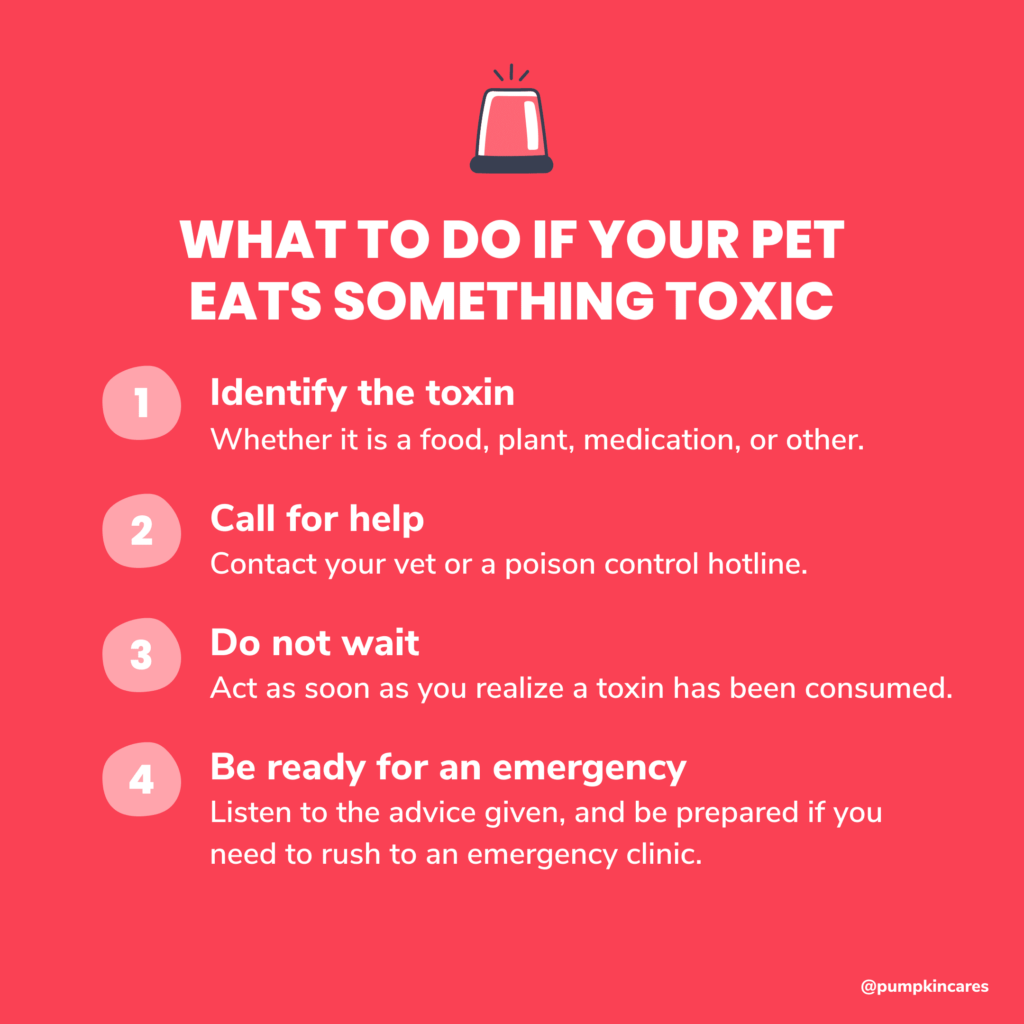Key Points
- When your dog swallows something toxic, it makes sense to think they should throw it up immediately. But this isn’t always the case – and inducing vomiting can actually do more harm than good.
- Never make your dog throw up without explicit direction from a veterinary expert.
- Learn the common foods and household items that can be toxic to your dog, and keep them in safe storage spaces where your pup cannot access them.
Turns out Lucy the Labrador has a sweet tooth: She downed an entire chocolate bar. As her loving pet parent, you’re likely feeling the panic rising, the question “How can I make her throw it up?” blaring inside your head.
But should you make your pup throw up? Read on for what to do if your dog swallows a toxic substance.
How can I make my dog throw up?
The answer: You shouldn’t.
When your dog ingests something harmful, it’s completely reasonable to think you should make them throw it up as quickly as possible.
But the saying “better out than in” doesn’t necessarily apply to your dog’s stomach. Inducing vomiting in your pet can put them at greater risk, and potentially cause serious damage to their health.
“Pet owners should never induce vomiting in their dogs at home without the explicit consent and direction of a veterinarian,” cautions Dr. Jamie Whittenburg (DVM), veterinarian director at Senior Tail Waggers and director of Kingsgate Animal Hospital in Texas. “If you suspect your pet has ingested something they shouldn’t have, you should never induce vomiting by yourself at home.”
If your dog swallows a toxic substance – some common pet poisons include grapes and raisins, chocolate, human medications and supplements, mouse and rat poison, fertilizers, and xylitol (the sweetener found in products like sugar-free gum) – the first thing you should do is call your vet or a pet poison helpline immediately.
“Not only is home induction of vomiting dangerous for your pet,” Dr. Whittenburg says, “whether or not vomiting should even be induced at the vet hospital depends on what toxin was ingested. Vomiting certain toxins can make things even worse.”
Throwing up batteries, for example, will very likely exacerbate an already dicey health situation. When punctured, common household batteries – such as acid and alkaline batteries, or button and disc batteries – can leak corrosive material into the digestive tract. Vomiting this caustic substance can damage your dog’s esophagus – leading to severe ulcers.

The dangers of inducing vomiting in your dog at home
Besides the dangers of throwing up corrosive or caustic substances, several other risks are associated with inducing vomiting in your dog without consulting a veterinary expert.
For one, you don’t always know that your dog has ingested something harmful until hours later, at which point it’s too late to induce vomiting. Or, they might have swallowed a sharp object, which could damage their organs if they throw it up.
Inducing vomiting in brachycephalic breeds – such as pugs, French bulldogs, and Pekingese – can be especially dangerous because of the risk of causing aspiration pneumonia.
What about hydrogen peroxide?
While many sources online claim hydrogen peroxide solution is a safe home remedy for inducing vomiting, most veterinarians warn dog owners that administering it at home can do more harm than good.
“Hydrogen peroxide can burn the esophagus and cause scarring of the inner lining, as well as strictures – which is when the inside of the esophagus narrows due to scar tissue,” says Dr. Whittenburg. “An esophageal stricture is a very serious and sometimes lethal complication that requires extensive treatment to remedy.”
And, to briefly interrupt this message with a PSA for cat owners: not only is hydrogen peroxide a severe irritant that should never be given to cats, but there is also no safe way to induce vomiting in your cat at home. Always seek veterinary care if your kitty ingests something poisonous.
What to do if you need your dog to throw up
Take your pup to the vet
Seeking veterinary care is by far the safest course of action to take when your dog swallows a toxic substance or foreign body. Because vomiting isn’t always an ideal remedy and can potentially cause further damage to your dog, your vet must carefully consider your pet’s health, the toxic substance ingested, and all the relevant factors at play before deciding on the best treatment.
If the vet is closed, call a pet poison helpline
It’s never good when our fur babies swallow something toxic, but it can be even worse when they ingest a harmful substance after hours.
If the vet office is closed, Dr. Whittenburg advises pet owners to call the ASPCA Animal Poison Control Center Hotline at 1-888-426-4435. “The service is available 24 hours a day,” she notes, “and is the best way to find out more about your pet’s risk after a toxin exposure.” If possible, pet parents should be ready to share the toxin’s label, the amount ingested, and their dog’s body weight when they call the hotline.
“If you need prompt medical care for your pet,” Dr. Whittenburg adds, “you should head to the nearest emergency hospital.”
What to expect from a vet visit
Your veterinarian will assess your dog’s symptoms and ask for information about the ingested toxin. After getting a holistic understanding of your pet’s situation, your vet might administer medication to induce vomiting – such as apomorphine or Clevor™ – or, in certain circumstances, recommend abdominal surgery. They might give fluids through an IV or keep your pup overnight for monitoring.
Tip: Having a great dog insurance plan can help cover costs associated with unexpected accidents and illnesses such as a toxin or foreign body ingestion.
If your vet induces vomiting, they will very likely give your dog something to settle their stomach after all the vomit has been cleared.
Once your pup is back home, your primary job is to keep them warm and comfortable. Wait for any nausea to subside – this usually takes a few hours – before slowly introducing small amounts of water and bland food.
Always speak to your veterinarian if your dog seems sick hours after the induction of vomiting or shows any other signs of illness.
Is it ever okay to make my dog vomit?
There is no 100% safe way to make your dog throw up. In rare instances – after remotely triaging your pet and assessing the particular situation – a vet professional might recommend you induce vomiting in your pup. If so, the only method they will likely suggest is following their precise instruction to administer a specific dose of hydrogen peroxide.
Your vet might recommend a 3% percent hydrogen peroxide solution and guide you through carefully administering the correct amount of hydrogen peroxide by mouth. Using a turkey baster or similar-sized syringe (one without a needle), squirt the solution between your dog’s back teeth, pulling back their lips and inserting the syringe into the side of their mouth. Typically, the recommended dosage is one teaspoon per five pounds of your dog’s body weight, with a maximum dose of three tablespoons for dogs who weigh more than 45 pounds.
You’ll need to keep a close eye on your pup after giving them the hydrogen peroxide solution: An irritant to the intestinal tract, the solution will likely make your dog vomit within 10 to 15 minutes. If vomiting doesn’t occur after 15 minutes, your vet may recommend administering a second dose, but never exceeding two doses. The vomiting could last for 45 minutes, so ensure your pooch is in a comfortable place – with you by their side.
Do not use higher concentrations of hydrogen peroxide or ipecac syrup – ingestion can cause serious harm to your pup. Refrain from making your dog throw up if they are already vomiting, are hyperactive or experience seizures, have had recent abdominal surgery or megaesophagus (a generalized enlargement of the esophagus), are severely lethargic, or are experiencing difficulty breathing.
Lastly, never try to gag your dog by sticking a finger down their throat. Dogs don’t have the same gag reflex as humans – so, not only will this method prove futile, but you could risk your pooch biting you out of discomfort or fear, causing trauma to both you and your dog’s throat.
What are the signs my dog needs to throw up?
Sometimes, you don’t always know if your dog has ingested something toxic that needs to be cleared from their intestinal tract.
“Unfortunately, most toxins will not cause any clinical signs until they’ve already been absorbed. By then, it’s much too late for vomiting to help,” says Dr. Whittenburg.
Still, there are some signs to look out for, Dr. Whittenburg notes, including nausea, drooling, lip smacking, refusal of food, or retching.
“If you suspect that your dog has ingested something toxic,” Dr. Whittenburg adds, “you should never wait for signs of illness to appear before seeking veterinary care.”
Common pet toxins to avoid
The best way to care for your dog’s health and keep them safe is to avoid any exposure to toxins. While puppy-proofing your home can certainly help, there are some foods and products that we use daily (and will likely not get rid of) that are dangerous to dogs if ingested.
Keep these common household items that are unsafe for dogs far from your pooch’s chops:
- Foods toxic to canines, which include alcohol, avocado, chocolate, coffee, citrus, coconut and coconut oil, grapes and raisins, nuts (especially macadamia nuts), garlic, onions, chives, milk and dairy (cheese is usually okay for dogs in small amounts – discuss with your vet first), raw meat and eggs, bones, salt and salty snacks, xylitol, and yeast dough (which can cause painful bloat)
- Household and backyard plants, such as sago palm, caladium, pothos, and many more favorite flora
- Household cleaning products, like bleach, freshly administered carpet powders and shampoos, essential oils, fabric softener sheets, alkaline grout, and vinegar
- Human medications and cosmetics, like Adderall, petroleum jelly, aspirin, caffeine, soaps and cleansers, breath fresheners, tobacco products (including cigarettes, nicotine patches, and e-cigarette liquid cartridges), NSAIDs like ibuprofen and naproxen, Pepto Bismol, mosquito repellant, pseudoephedrine (and other nasal decongestants), sorbitol, and topical creams and ointments
- Antifreeze, which can cause lethal harm in even the smallest amounts
The bottom line? While it can feel urgent – even instinctual – to make your dog throw up, if you act before consulting your veterinarian, you risk harming your precious pup. You’re better off giving your vet and the pet poison hotline a call before trying to induce vomiting.
- https://www.petpoisonhelpline.com/pet-owners/basics/top-10-pet-poisons/
- https://www.preventivevet.com/dogs/dogs-and-the-dangers-of-swallowing-batteries
- https://www.aspca.org/news/it-ever-safe-induce-vomiting
- https://www.aspca.org/pet-care/animal-poison-control
- https://www.aspca.org/pet-care/animal-poison-control/poisonous-household-products



